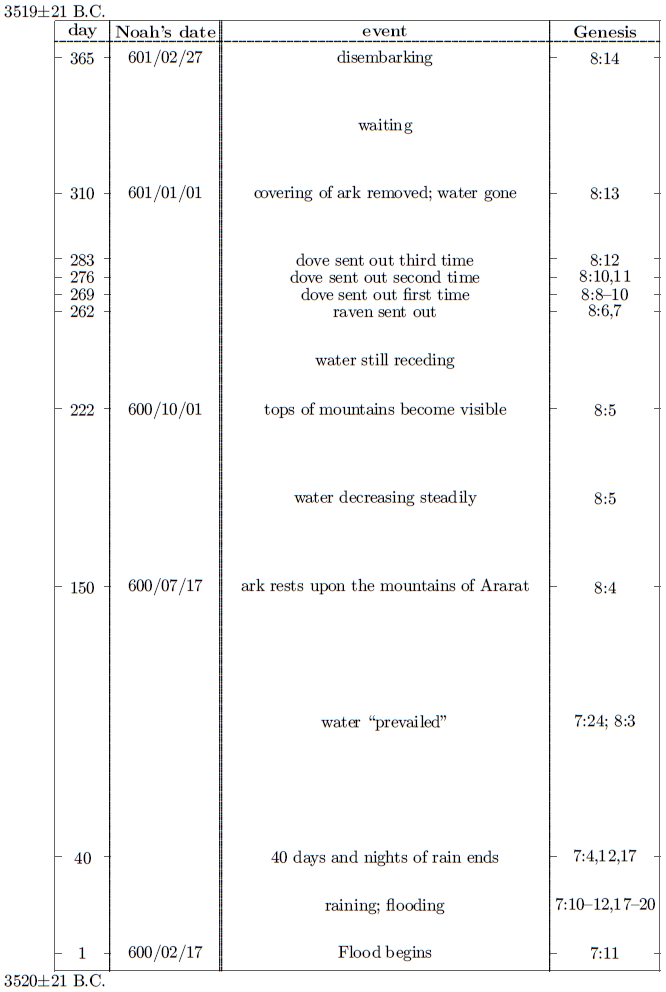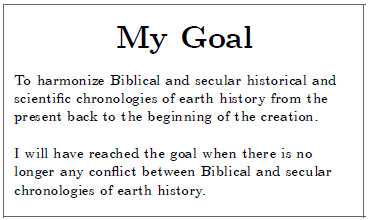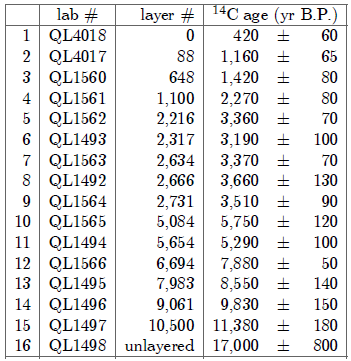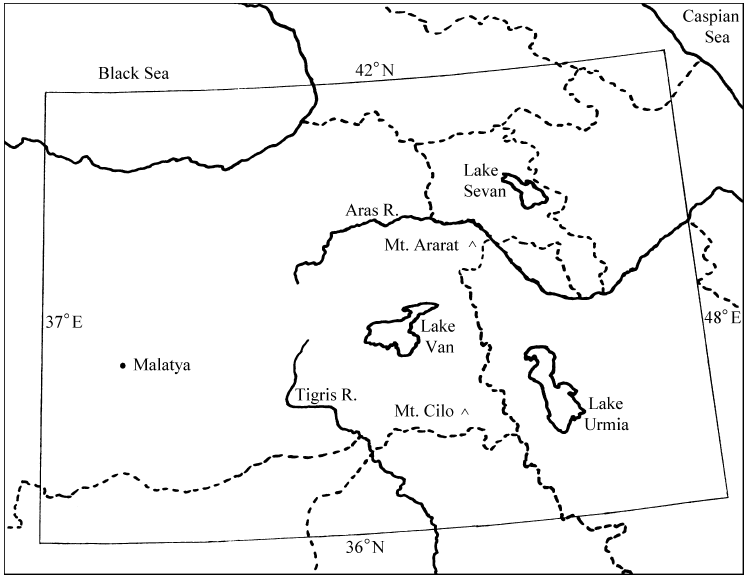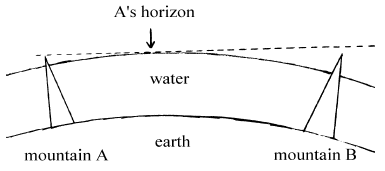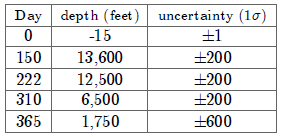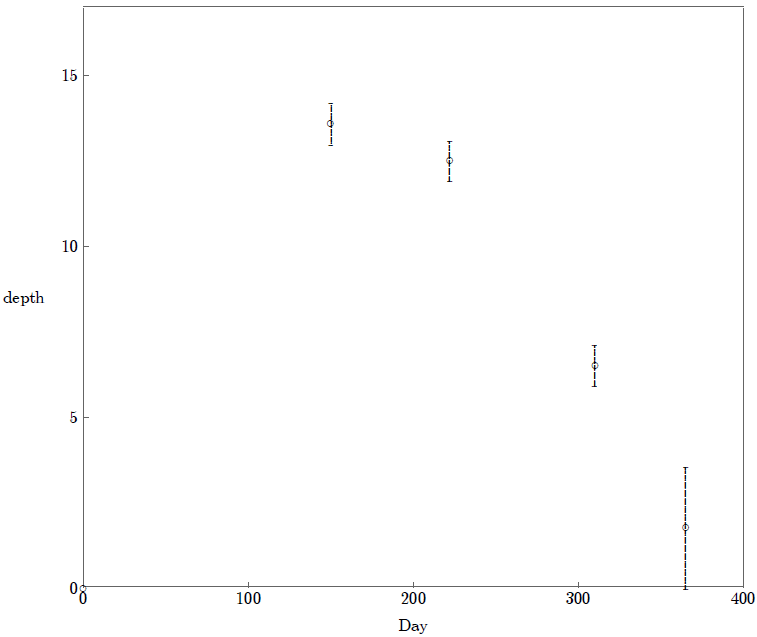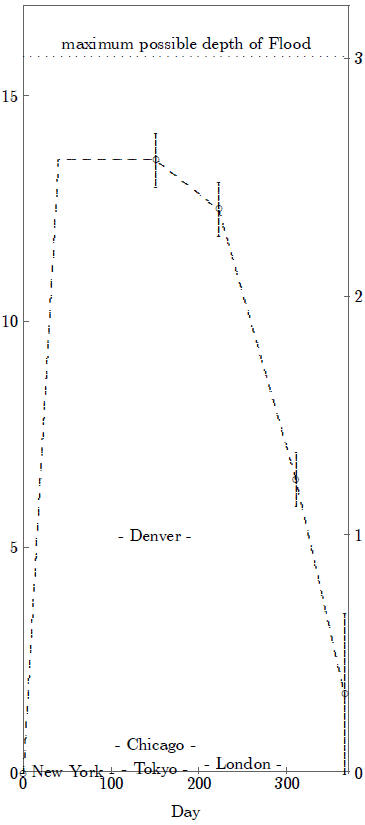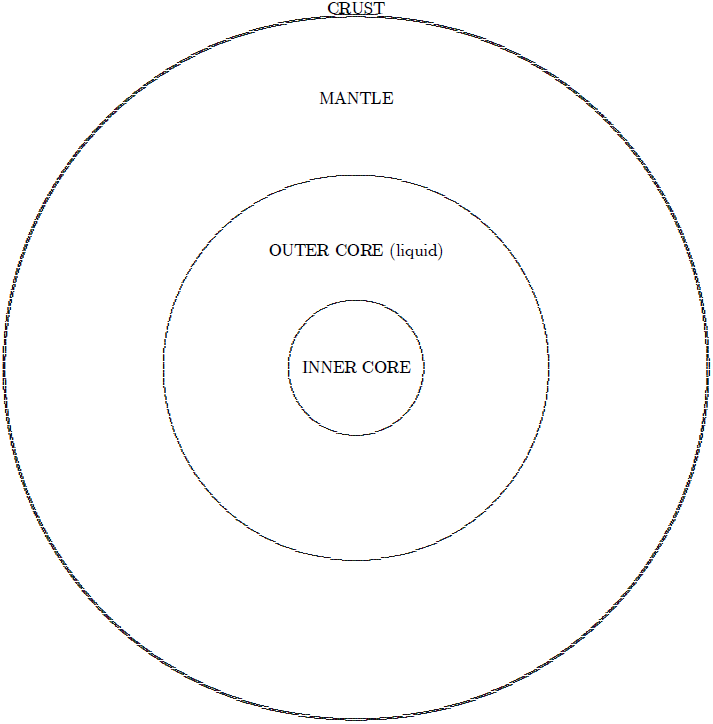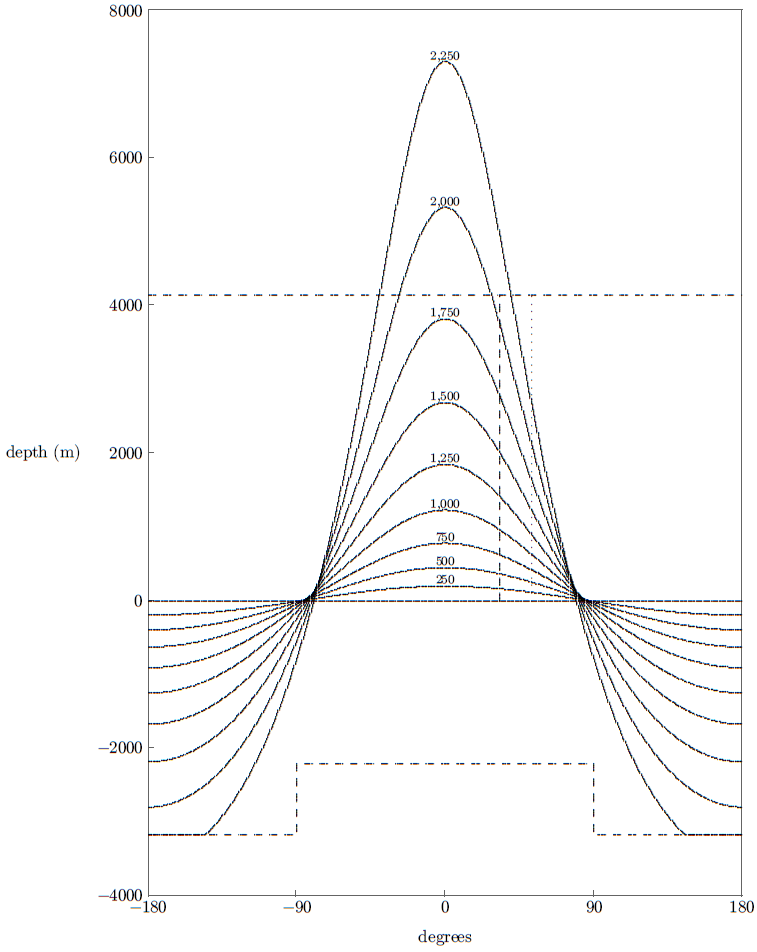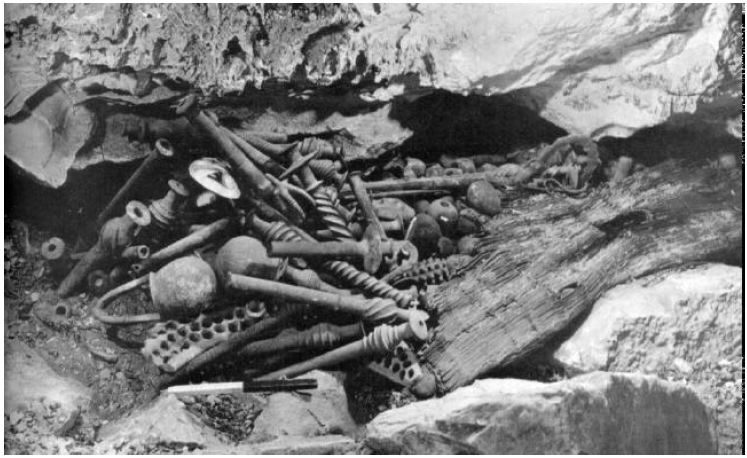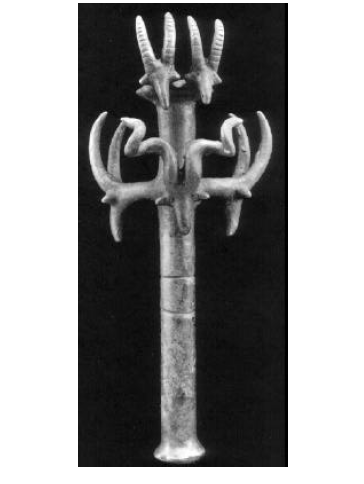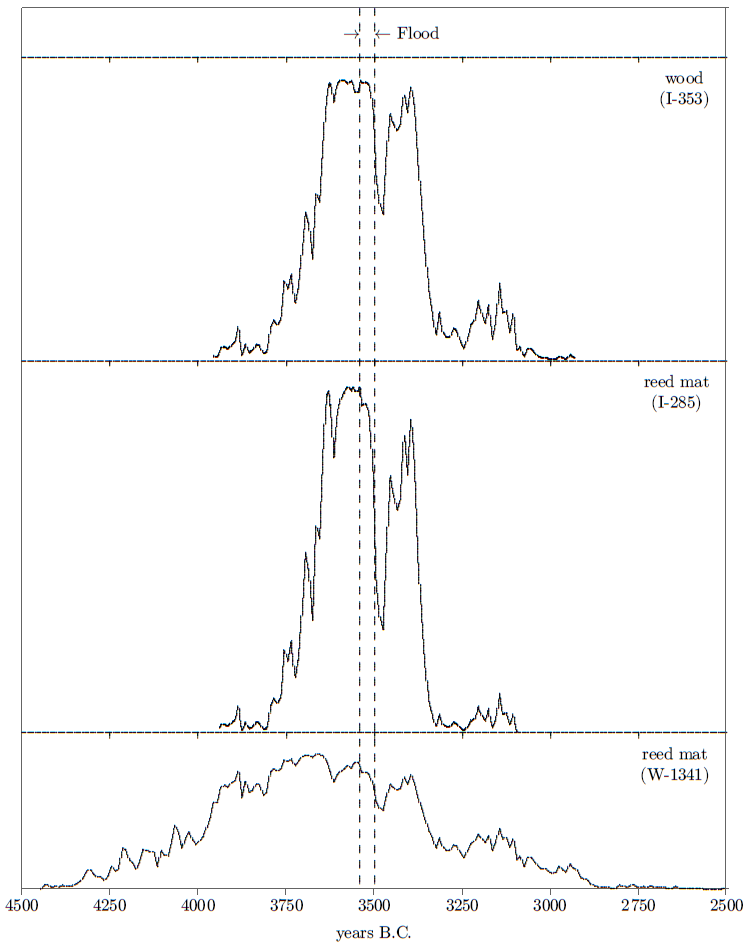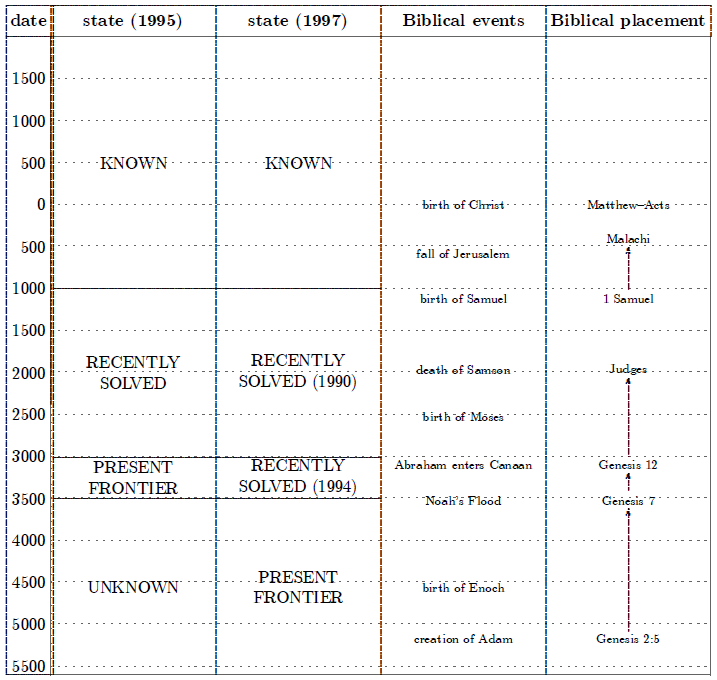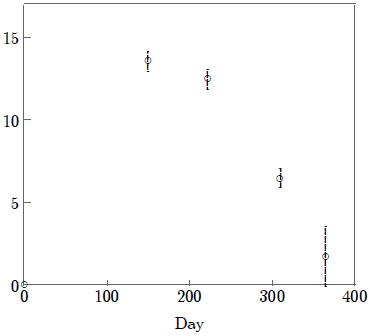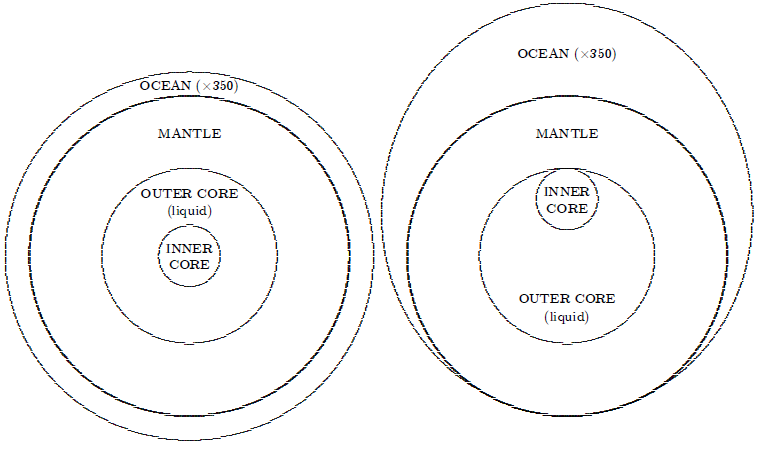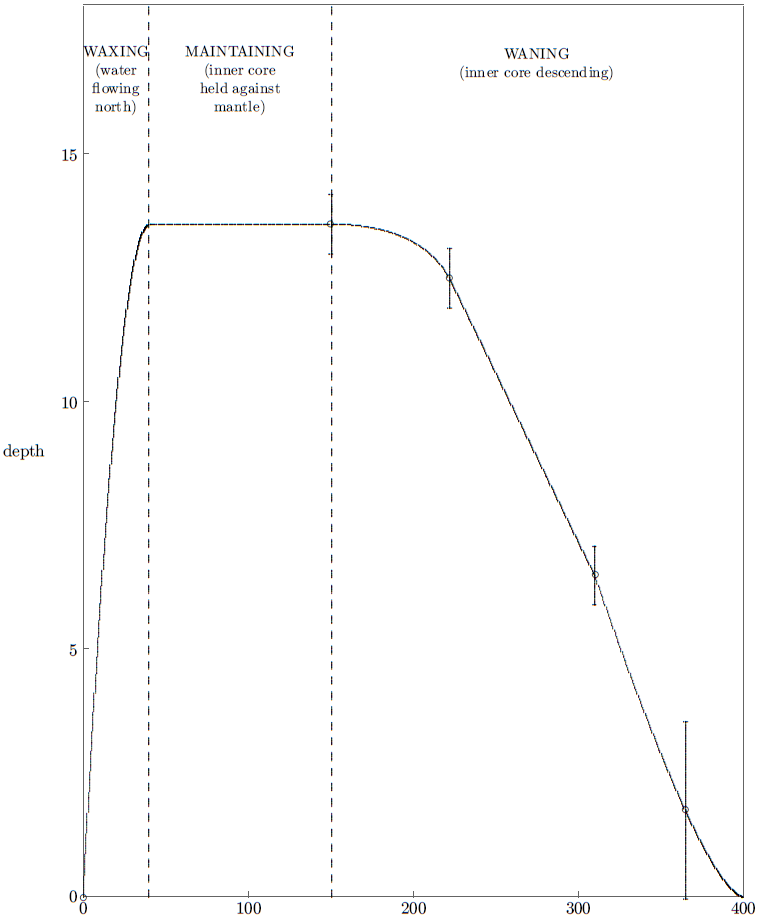 |
| Volume 3, Number 4 | July/August 1997 |
Noah's Flood at Devon Island
Vast ice sheets, often over a mile thick, cover many land areas in the polar regions of the globe today. These are the result of the buildup of annual snowfall over thousands of years. The oldest ice in these ice sheets predates Noah's Flood by millennia. What impact would Noah's Flood have had on these ice sheets? What can these ice sheets tell us about the date and nature of Noah's Flood? The following article deals with these and related questions. It shows that Noah's Flood was a real historical event which occurred roughly 3500 B.C.
In the November/December 1996 issue of The Biblical Chronologist I introduced the pelagic Flood model.[1] The conceptual basis for this model is summarized by the following three statements:
Noah's Flood was a real historical event.
Noah's Flood is accurately portrayed in Genesis.
Biblical chronology, properly done, dates Noah's Flood to 3520±12 B.C.[2]
In its present (infant) stage of development the model itself can be summarized by two statements:
Noah's Flood was characterized by the existence of a near-global ocean for a significant fraction of one year near 3500 B.C.[3]
The surface of the Flood-ocean rose some two to three miles above the elevation of the surface of the present day oceans of the world.[4]
This conception of the Flood stands in contrast to the nearly unanimous view of secular academia at present that the Genesis story of Noah's Flood is largely or wholly mythological.[5] It also stands in contrast to the cataclysmic Flood model which pictures Noah's Flood as dominated by titanic upheaval within the crust of the earth, and massive sedimentation globally.[6] Finally, it stands in contrast to the local Flood model which sees the Flood as a relatively mild, local inundation.[7]
I was caused to advance the pelagic Flood model by sediment thickness data from the bottom of Elk Lake, Minnesota, in combination with archaeological data from the Middle East. The archaeological data revealed a sudden, widespread termination of civilization near 3500 B.C. in immediate harmony with the Biblical account of the Flood.[8] But there was no evidence that this termination was accompanied by catastrophic upheaval within the crust of the earth. To the contrary, archaeological remains from before this termination were well preserved, and were generally found in the stratified sequences normal to archaeology.
The Elk Lake sedimentary data provided a geological counterpart to the archaeological data. They too failed to show any evidence of cataclysmic upheaval.[9] What they did reveal was an apparently annual accumulation of sediment some 500 times thicker than normal at 3500 B.C.[10] This seemed to provide geologic evidence that the Flood was indeed a world-wide phenomenon—that the earth was covered by a world-wide ocean at the time of the Flood.
The testimonies of these three sources of information regarding the Flood—the Genesis account, the archaeological data from the Middle East, and the geological data from Elk Lake—summed to produce an image of a global, non-cataclysmic, ocean-like Flood near 3500 B.C. Hence the pelagic Flood model was born.
But the possibility remained that the anomalously thick annual layer of sediment found at Elk Lake might have been caused by some unknown process which was unrelated to Noah's Flood. It was possible (though it did not seem probable) that this anomalously thick layer dated to the same time as Noah's Flood by mere coincidence. An independent check of this geologic evidence was clearly called for to settle this question.
The present article fills the need of this independent check. It investigates the thousands-of-years record of snow accumulation in Arctic ice sheets. It finds the pelagic Flood model to be strikingly confirmed by these ice sheets, and other views of the Genesis Flood to be demonstrated false.
The Check
The Elk Lake sediments constitute a natural reservoir of year-by-year data stretching back some ten thousand years. To carry out the desired check of the pelagic Flood model another such natural reservoir of year-by-year data was needed. In addition to this fundamental chronological requirement of year-by-year data stretching back on the order of ten thousand years, this other reservoir needed to meet several criteria to be of use in the present context. To avoid the possibility that lakes were all somehow affected by an event near 3500 B.C. which was unrelated to the Flood, it was clear that this other reservoir should not be another lake. Additionally, this other reservoir should be one on which the expected impact of the pelagic Flood would be large, so that the Flood could not possibly be missed in its year-by-year record. And, to provide a rigorous test of the model as it currently stands, this other reservoir should be one on which the impact of the Flood might be predicted in some detail.
These requirements constitute a very tall order. There are not many year-by-year chronologies stretching back ten thousand years in the natural world. But there are two possibilities which are somewhat prominent today because of the considerable coverage they have received within the technical scientific literature in recent decades. These two obviously deserve investigation. They are tree-rings and ice cores.
Tree-rings
As it turns out, tree-rings are not suitable to the present check. The reason for this is that the impact of the pelagic Flood on the tree-ring data set is not expected to be large.
To see this, consider the bristlecone pine chronology as an example. This is the first and most spectacular, long chronology of tree-rings to have been developed.[11] It stretches in an unbroken sequence of overlapping ring patterns from both living and dead trees back to 6700 B.C.[12]
The bristlecone pine trees from which this chronology was constructed live at an elevation of 10,000 to 11,000 feet in the White Mountains of California.[13] The pelagic Flood model specifies that this elevation would have been under about a half mile of ocean water for about half a year during the Flood.[14] Thus the bristlecone forest probably spent about six months in a cold, dark, ocean-floor environment during the Flood. Since it is obviously difficult to immerse a bristlecone pine forest a half mile deep in ocean water for half a year at present, there is an understandable dearth of experimental data on what such an immersion would do to such a forest. But several characteristics of these trees suggest that such an episode might not leave a detectable impact on their ring growth.
The length of the growing season for bristlecone pines in the White Mountains today is only about 45 days.[15] If the pelagic Flood inundated these trees for a number of months during their ten and a half months of natural dormancy it seems possible they may have been able to resume their usual growth with relatively little upset following the Flood. On the other hand, if the Flood covered these trees during the normal growing season, ring growth may have been highly attenuated on all bristlecones for the Flood year. But these trees grow in a difficult environment in any case, so that very narrow or even entirely absent annual rings are hardly a unique circumstance. Ferguson notes, for example, that "in some instances, 5 percent or more of the annual rings may be missing along a given radius that spans many centuries".[16] Thus, the same outcome seems to follow whether the bristlecones were weakly or strongly impacted by the Flood—the impact of the Flood does not seem likely to be easily detected within the record of their rings.
Bristlecone Chronology
In contrast to its less-than-obvious impact on tree-rings, the pelagic Flood may have had a detectable impact on the bristlecone pine chronology itself. It may have made extension of the chronology to more than a few thousand years before the Flood very difficult. The reason for this is that any dead remnants of trees not anchored to the forest floor at the time of the Flood would have been floated away by the Flood. Such dead remnants would naturally have contained most of the oldest wood present within the bristlecone pine forest at the time of the Flood. Thus I would expect the Flood to make the task of locating very old wood today—from more than one or two millennia before the Flood—unexpectedly difficult.
This expectation could probably be suitably quantified and tested by working with data which might be gathered from the present-day bristlecone pine forest. Unfortunately, I have not been able to find any data of the sort which is needed for such a study in the published literature at present, so it seems impossible to pursue this particular possibility any further here.
The conclusion regarding tree-rings is, therefore, that they do not seem to lend themselves immediately to the independent check of the pelagic Flood model which we require.
Please do not misunderstand this conclusion. I am not suggesting that no effect of the Flood on tree-rings will ever be found, by any means. I fully expect the opposite, in fact. But at this stage in the overall argument a blatant, unavoidable, obvious sort of evidence is needed, and tree-rings do not seem to furnish that kind of evidence.
Fortunately, quite the opposite conclusion applies to ice cores.
Ice Cores
Sheets of ice of great thickness are found to cover both large and small land areas in the polar regions of the globe today. The pelagic Flood model expects no major difference in the pre-Flood and post-Flood climates,[17] so these large ice sheets are expected to have existed pre-Flood as well, and simple chronological considerations show that indeed they did. What impact would the pelagic Flood have had upon these ice sheets?
Two possible causes of unusual effects upon these ice sheets during the Flood immediately suggest themselves. The first cause is an unusual annual accumulation of precipitation in the year of the Flood. This is suggested by the forty days and nights of rain which Noah observed. The second cause is the action of the Flood water itself on these large ice masses.
Forty Days and Nights of Rain
The effects of the first cause are, unfortunately, difficult to predict. This difficulty arises in a number of ways. For one thing we do not know whether Noah's observation of forty days and nights of rain implies similarly intense, prolonged precipitation globally, or whether this particular manifestation of the Flood was merely a local phenomenon. Additionally, we do not know what form precipitation would have fallen in (i.e., whether rain or snow) in the polar regions at the time of the Flood. There is no reason to suppose it fell everywhere in the same form. It probably varied spatially as well as temporally in form and frequency during the Flood.
If the surface of an ice sheet was above water at the time of the Flood (more on this below) and there was intense and prolonged precipitation at that ice sheet in the form of snow, then an unusually thick annual layer of ice should be found today within that ice sheet at the depth corresponding to 3500 B.C. If, on the other hand, rain was received instead of snow, then some meltback of the top ice might be expected. In that case a hiatus in ice chronology would be expected immediately prior to 3500 B.C.
Notice that the foregoing scenarios lead to opposite predictions—an unusually thick layer in the one case, and meltback in the other. Clearly our ability to make a definitive prediction of the effect of the forty days and nights of rain on the polar ice sheets is not good.
But we are able to do much better with the second cause—the action of the Flood water on the ice sheets.
Action of the Flood Water
We can predict with a high degree of confidence that the pelagic Flood would have caused some melting of the ice sheets wherever the water of the Flood came into contact with them. Ice at atmospheric pressure melts at 0°C. At 300 atmospheres pressure, such as would be encountered under a two mile water column, ice melts at -2.32°C.[18] Meanwhile, deep ocean water is typically within a few degrees of 4°C.[19] Deep ocean water makes up most of the bulk of the oceans today and is expected to best approximate the water of the Flood which would have come in contact with the ice sheets. Thus the Flood-ocean is expected to have melted the ice sheets wherever it came in contact with them. The rate of melting would depend on the actual temperature of the Flood water at a given time and location, in addition to other factors, of course, but melting is expected in any event.
The next question which arises in this context is whether it would be the top or the bottom of an ice sheet which would be in contact with the water of the Flood. The depth of the Flood specified by the pelagic Flood model is considerably greater than the average elevation of any of the polar ice sheets today. Thus these ice sheets must either have been submerged by the Flood or they must have floated upon it. If an ice sheet were to float then clearly it would be the underside of the sheet which would be melted by the Flood water. If, on the other hand, an ice sheet were to remain submerged during the Flood, then the top of the sheet would be melted back.
It is well known that ice floats in water. Even the highly pressurized ice at the bottom of a large ice sheet will float since it is less dense than water. But many ice sheets are observed to be frozen to their beds at present. This is like having a block of wood glued to the bottom of a pail. If you fill the pail with water, the block of wood will experience a buoyant force tending to make it float. If the glue is weak the block will break loose as the water rises and it will float. But if the glue is strong enough the block will stay glued to the bottom and be submerged.
Whether an ice sheet would float or remain under water during the Flood depends on whether the buoyant force on that particular ice sheet was strong enough to overcome the "glue"—in this case, the tensile strength of the ice itself—holding it to its bed. Clearly, we would like to be able to predict which ice sheets would break loose and float and which would remain frozen to their beds so we can predict whether a given ice sheet would have been melted on its topside or its underside.
To Float or Not to Float
Whether an ice sheet would float or not can be calculated using the fundamental laws of physics and the measured properties of glacier ice. Figure 1 shows the basic problem. If the force of buoyancy, Fb, acting on an ice column due to the presence of water is greater than the weight of the ice column, Fg, plus the force due to the ultimate tensile strength of the ice, Ft, holding it to its bed, then the ice will break away from the bed and float. Otherwise it will stay submerged.
Figure 1: Forces acting on an ice column of mass m frozen to bedrock under water.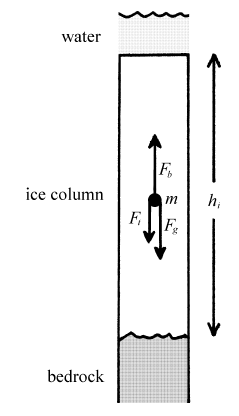 |
The force of buoyancy on the ice is, according to Archimedes' principle, just equal to the weight of the displaced water. Let ρw represent the density of sea water, Vi represent the volume of the column of ice shown, and g represent the acceleration due to gravity. Then

Let ρi represent the density of the ice. Then

At the breaking point the buoyant force will be equal to the sum of the other two forces.

Substituting for Fb and Fg gives

Rearranging gives

Let the cross-sectional area of the column of ice be Ai and its height be hi. Then

Solving these last two equations for hi yields the desired result.

Substituting values for the quantities on the right side of this equation will give us the critical height of a column of ice. An ice sheet which is on average thicker than this critical height will be expected to break away from its bed and float, while thinner ice sheets will remain frozen to their beds and be submerged.
The quantity Ft / (Ai g) (the ultimate tensile strength of ice) has been measured by a number of investigators. W. F. Weeks found a value of 29.6±8.5 kg/cm2 for fresh-water ice produced in the laboratory.[20] Butkovich found values within this range for measurements on glacier ice[21] as did Langleben and Pounder for sea ice[22].
The density of ocean water varies slightly with temperature, salinity, and pressure. For the present case a value for ρw of about 1033 kg/m3 seems most appropriate.[23]
The density of ice varies with depth in an ice sheet. Icebergs are pieces of ice sheets which have broken off into the ocean. They should provide a representative value of ice density for ice sheet ice. Pickard and Emery give the density of iceberg ice as "about 900 kg/m3".[24] Given the large uncertainty in the ultimate tensile strength of ice cited above, this estimate should be adequate for the present calculation.
Substitution of these values into Equation 2 yields a critical height of about 2,200±600 meters (7,300±2,100 feet) for an ice sheet to break free of its bed due to buoyancy.
The Greenland and Antarctic Ice Sheets
The uncertainty in this quantity is, unfortunately, large. This hampers our ability to make clear-cut predictions for ice sheets having average thicknesses near 2,200 meters. Applying the usual rules from the branch of mathematics known as statistics to the calculated critical height and its uncertainty indicates that there is about a two in three chance the true critical height for ice sheets lies somewhere between 1,600 and 2,800 meters. Conversely, there is about a one in three chance it lies outside this range. But there is only about a five percent chance it lies outside the range 1,000 to 3,400 meters, and less than a half of one percent chance it lies outside the range 400 to 4,000 meters. The further away the average thickness of an ice sheet is from the calculated critical height, the more confidently we can predict whether that ice sheet would have floated or remained submerged during the Flood.
Unfortunately (though not terribly so, as we will see below) the average thicknesses of the largest (and most intensely studied) polar ice sheets—the Greenland and Antarctic ice sheets—appear to be comparable to the critical height. I have not been able to find a figure for the average thickness in either case, and it may be that the average thicknesses are not yet known. But the Greenland ice sheet was found to be 2,037 meters thick when drilled through to bedrock at Dye 3, and the Antarctic ice sheet was found to be 2,164 meters thick when drilled through to bedrock at Byrd Station. Both thinner and thicker sections than these exist within these ice sheets, so we cannot just treat these point measurements as averages, of course. The borehole at Camp Century, Greenland, penetrated to bedrock in just 1,365 meters, for example, and Shoji and Langway claim that "the maximum thickness of an inland polar ice sheet is between 3000 m and 4000 m".[25] But it is clear, in any case, that the average thicknesses are not sufficiently distinct from our calculated critical height of 2,200±600 meters to allow an assured prediction for these two very large ice sheets.
But ice cores have also been taken from a few smaller ice sheets, and here, fortunately, a solid prediction is possible.
The Devon Island Ice Cap
The most intensely studied smaller ice sheet appears to be an ice cap on Devon Island in Northern Canada. (See Figure 2.) This is the only small ice sheet which I have been able to find so far for which chronological data adequate to the present purpose exist. It is also well suited to the present investigation in that its oldest ice dates much further back than 5,500 years ago.
Figure 2: Map showing locations of bore hole D72 on Devon Island and Camp Century on Greenland.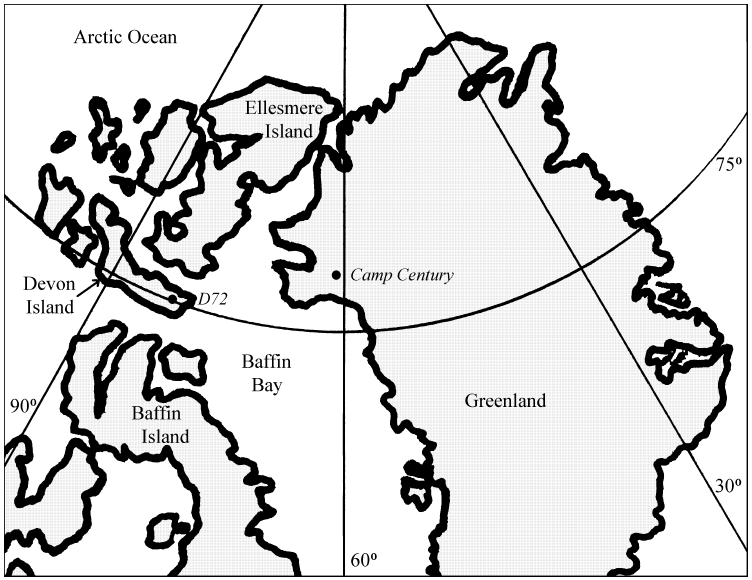 |
This "small" ice cap on Devon Island is still quite massive. It covers an area of nearly four million acres (15,600 km2).[26] Two bore holes, D72 and D73, were drilled through the Devon Island ice cap to bedrock. D72, drilled in 1972, was 298.9 meters deep. D73 was drilled in 1973 and was 299.4 meters deep. Patterson reports that "measured ice thicknesses are in the range 200 to 1,000 m".[27] Thus, an average thickness much less than the critical height of 2,200±600 m calculated above is indicated, and we may confidently predict that the Devon Island ice cap would have remained frozen to its bed throughout the pelagic Flood.
This leads immediately to a second prediction. The elevation of the ice does not exceed 2,000 meters (6,500 feet) at present. The pelagic Flood model specifies a water depth at least a mile in excess of this elevation for about half a year.[28] Thus, the ice must have been submerged under about a mile of ocean water for about half a year. Significant meltback of the top side of the ice cap during the Flood is predicted.
Is there any evidence confirming these predictions? Indeed there is.
Evidence #1
That the Devon Island ice cap remained frozen to its bed 3500 B.C. is directly supported by the ice cores, D72 and D73, taken from the ice cap. From study of these cores glaciologists Koerner and Fisher concluded "the ice has almost certainly been frozen to its bed throughout its history".[29]
Evidence #2
If the top of the ice cap was melted back significantly during the Flood as predicted and new ice began to accumulate again after the Flood, then the ice cores which were taken from the ice cap might be expected to show a discontinuity of some sort between the old pre-Flood ice and the new post-Flood ice.
A discontinuity in the comparison of measured oxygen isotope ratios in the two cores shows up 13 meters above the base of the Devon Island cores. Paterson et al. reported that:[30]
The [oxygen] isotope profiles from the two boreholes closely resemble each other except near the base of the ice. The correlation between 50-yr mean δ [oxygen isotope ratio] values is 0.965 between the surface and 13 m above the bed, but only 0.449 between 13 and 5 m.
The two cores were drilled only 27 meters apart. Effort was made to situate them on the same ice flow line. Thus their oxygen isotope ratios should closely resemble one another. The fact that they do not do so below 13 meters above bedrock is clear evidence of some sort of disturbance.
I suggest that the upper sections of core which show good correlation represent post-Flood ice, while the lower 13 meters which show poor correlation between the two cores is pre-Flood ice. Some of the loss of correlation in the bottom ice may be due to perturbations in ice flow over an uneven bed, especially in the lowest few meters. But I suggest the principle reason the sections from the two cores between 13 and 5 meters show poor correlation is because the pre-Flood flow lines were different than the presently observed flow lines. This would mean that the ice in these lower sections may have originated from quite different places on the surface of the pre-Flood ice sheet. In that case the overall trends in oxygen isotope ratios would be expected to be similar (as is observed) but detailed correlation would not be expected.
Evidence #3
If the Devon Island ice cap was melted back at the time of the Flood and the Flood happened 3520±21 B.C., then the date of the oldest post-Flood ice should be within ice core dating uncertainties of 3520±21 B.C.
We have just seen that the expected discontinuity between pre-Flood and post-Flood ice is at a depth of 13 meters above the bedrock. Thus, the oldest post-Flood ice will come from this depth. The date of ice at this depth can be determined in a fairly straightforward manner from the stratigraphy of the ice itself. The chronological data in this instance are the measured annual layer thicknesses at various depths along the borehole. These are determined using the ice cores which were taken from the ice sheet. Seasonal variations in measured microparticle (i.e., dust) concentrations are used as the means of distinguishing one year from the next—annual snow layers soon lose all visual distinctiveness because of compression by overlying layers and conversion to solid ice.
It would be very nice if we had a continuous series of microparticle measurements from the top of the ice core to its base. In that case we would be able to simply count the annual layers of ice from the top down to 13 meters above bedrock. This would provide the most simple method of ascertaining the date of the ice at 13 meters. However, while this method provides for simple chronology, it requires a very large effort in the laboratory.
To discern yearly oscillations in microparticle concentration one needs to make separate measurements on at least two samples from each annual layer. This means that to date back to five thousand years ago by counting annual microparticle oscillations, the microparticle concentrations of at least ten thousand samples of ice would need to be measured in the laboratory. (In actual practice, of course, one would want to measure four or more samples per year to adequately resolve the annual signal.)
Rather than go to the enormous amount of work and expense required to measure microparticle concentrations throughout an entire ice core, it is easier and quicker (though less accurate, of course) to measure microparticle concentrations in detail at a relatively small number of depths along the core and interpolate these measured values. This is what has been done with the Devon Island cores.
Figure 3 shows a graph of measured annual layer thicknesses versus depth for the Devon Island ice core, D72. I have obtained the data for this graph (see Table 1), evidently due to Fisher and Koerner, from a paper by Reeh and Patterson.[31] I have interpolated the measured data points with straight lines, and linearly extrapolated the last two points to the 13 meter-above-bedrock depth.
Figure 3: Annual layer thickness versus ice-equivalent depth in D72 ice core.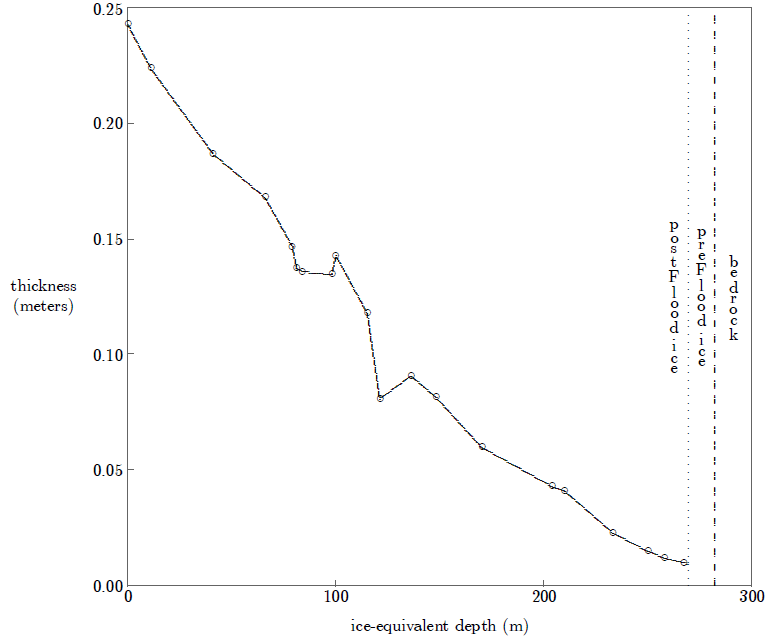 |
Table 1: Measured annual layer thicknesses at various ice-equivalent depths from core D72. Depth and thickness are both in meters. |
The total length of ice and snow in the D72 core was 298.9 meters, as mentioned above. For modeling purposes it is common to work with "ice-equivalent" depth rather than measured depth. This is the depth along the ice core one would have measured if the snow at the top of the ice sheet had been compressed into ice. Such theoretical compression shortens the D72 core by 17 meters.[32] Ice-equivalent depth was used in Figure 3 because ice-equivalent depth was used in the data table from which the plotted data were obtained.
The mathematical transformation from measured depth to ice-equivalent depth does not compress the bottom of the ice sheet, which is already made up of ice. Only the upper layers are compressed. Consequently, 13 meters above the bedrock is still the point corresponding to the oldest post-Flood ice. The ice-equivalent depth of this point is (298.9 - 17 - 13 =) 269 meters.
The elapsed time between the top of the ice sheet and 269 meters ice-equivalent depth is found by calculating the integral:

where λ is the measured annual thickness at depth h.
This integral can be calculated in the straight line interpolation case shown in Figure 3 by computing the sum:

In this equation the hi's and λi's are the coordinates of the twenty points shown in Figure 3. The points are enumerated with i=1 at the top of the ice sheet. h21 is the ice-equivalent depth of the oldest post-Flood ice (i.e., 269 meters), and λ21 is obtained by linear extrapolation of points 19 and 20 to this depth.
This sum yields 5,401 years. Subtracting the date of drilling (1972) yields 3429 B.C. as the best estimate of the 13 meter-above-bedrock ice. This is only 91 years different than the Biblical date for the Flood (i.e., 3520±21 B.C.). While it is difficult to assess the uncertainty in this calculated ice core date arising from the interpolations and extrapolation used, it must certainly be greater than a century. Thus, the oldest post-Flood ice is found to be within ice core dating uncertainties of the Biblical date for the Flood as required.
Evidence #4
According to conventional secular scientific wisdom (which presently makes no allowance for Noah's Flood) the climate at Devon Island (as also elsewhere) should have been more or less uniform since the last ice age some ten thousand years ago. The accumulation of snow on Devon Island, though fluctuating from year to year, is expected to have been approximately constant on average with no significant long term trend. The temperature, too, should have been roughly constant on average. And since nothing (like Noah's Flood) is known to secular science which might have upset the simple year-by-year accumulation and loss of ice at Devon Island, conventional wisdom says the Devon Island ice cap should be able to be successfully modeled assuming steady state conditions within the ice cap today.
But if the Devon Island ice cap experienced significant meltback at the time of the Flood, then efforts to mathematically model the present dimensional parameters of the ice cap (i.e., its height, annual layer thicknesses, horizontal extent, etc.) which assume steady state (and thereby ignore this meltback) should not succeed.
Paterson and Waddington applied a steady state model to the Devon Island ice core data in 1984 and found, much to their surprise, that it didn't work. They concluded "the steady state assumption has broken down".[33]
Because the Devon Island ice cap was significantly melted back by the Flood in the relatively recent past, steady state assumptions will not work when modeling this ice cap.
Evidence #5
Normally the total thickness of a mature ice cap remains roughly constant from year to year. This results from the fact that old ice is squeezed out the sides of the ice cap, by the weight of the overlying ice and snow, at the same rate as new snow accumulates on top each year. But if a significant amount of snow and ice is removed from the top side of an ice cap then this normal balance will be lost. Flow of old ice out the sides will slow down because there is no longer enough weight to squeeze the ice out as previously. Consequently, the ice cap will begin to thicken again. Thickening will continue until the old equilibrium thickness has been regained.
If the Devon Island ice cap experienced significant meltback at the time of the Flood, then thickening of the ice cap due to regrowth since the Flood is expected.
Evidence for thickening comes from oxygen isotope analyses of the ice. Oxygen isotope analysis, mentioned already above in connection with the 13 meter discontinuity, is a standard tool of science used more or less routinely in the study of ice cores. The ratios of isotopes of oxygen (oxygen atoms of differing masses) are measured in the ice. This ratio is sensitive to changes in temperature and also to changes in the altitude at which the snow was deposited. If the Devon Island ice cap was thinner in the past, then snow would have been accumulating on the ice sheet at a lower altitude in the past. In that case the oxygen isotope ratio should be higher in the older ice than it is in the modern ice.
In point of fact the measured oxygen isotope ratios graph shows a distinct linear trend from higher to lower values from just above the 13 meter discontinuity to the present as is shown in Figure 4.[34]
Figure 4: Oxygen isotope ratios measured versus depth in the Devon Island ice cap. Scale at left is δO18 in parts per thousand. (Data are from Paterson et al. See footnote 34 for reference.)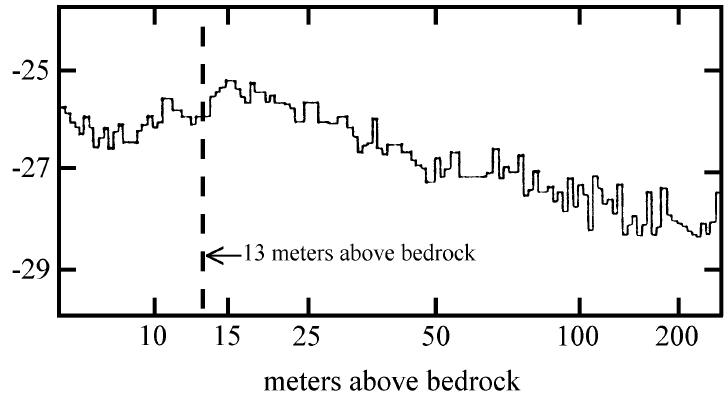 |
Interestingly, this trend furnishes us with a quantitative estimate of how much the Devon Island ice cap was melted back by the Flood. Paterson et al. observe, "the additional 1.6‰ [per thousand change in the measured oxygen isotope ratio] at Devon Island would correspond to a thickness change of about 250 m".[35] Since the ice cap is currently 300 meters thick at the drill site, this suggests that only about 50 meters of the original ice cap remained following the Flood. (This original 50 meters has thinned to just 13 meters today due to the weight of the overlying ice.) That is, in excess of 80% of the pre-Flood ice cap was melted away by the waters of the Flood.
As an interesting aside, the upper 250 meters of the ice cap represent about 3,000 years of accumulation today. Thus it is possible to estimate that about 3,000 years of pre-Flood chronology were lost from the Devon Island ice cap at the time of the Flood. This implies that a 3,000 year hiatus exists at the 13 meter-above-bedrock discontinuity in the D72 ice core chronology. This prediction could possibly be tested by radiocarbon measurements on ice taken above and below the 13 meter discontinuity.
Evidence #6
If the Devon Island ice cap experienced significant meltback at the time of the Flood, then the measured annual layer thicknesses of ice in the D72 core should be found to be increasingly too thick with depth relative to steady state expectations.
To see this, consider the time development of an ice sheet following a meltback. (See Figure 5.) For the sake of simplicity, assume the ice sheet receives just one foot of snow each year and that it has been melted back to bedrock. (The depth and time scale are unimportant here; it is only the principles which are important.) In the first year after the meltback the snow will accumulate to one foot depth above bedrock. In the second year another foot of snow will accumulate. This will weigh down the first year's accumulation and compress it somewhat. For the sake of simplicity once again, assume that each layer compresses each year to one half the thickness it had the year before due to the weight of the overlying snow. (In real life thinning occurs by compression near the top, giving way to horizontal flow of ice as one moves deeper in the ice, but such details are unimportant here.) If this is allowed to go on indefinitely simple mathematics shows that this hypothetical "ice sheet" will achieve a steady state thickness of two feet.
Figure 5: Simplified illustration of the growth of an ice sheet showing how bottom layers thin while upper layers retain their same thickness as the ice sheet ages.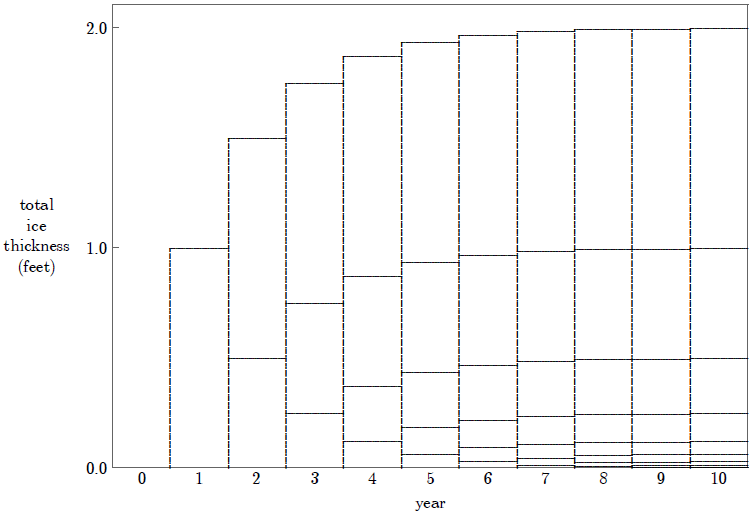 |
Figure 5 shows the approach to steady state for the first ten years in this case. Compare the ice sheet layer thicknesses after four and ten years. Notice that the upper layer thicknesses are identical—the only difference is that they are at a lower altitude at four years than they are at ten. In contrast to this, however, the bottom layers in the four-year-old ice sheet are much thicker than those in the ten-year-old ice sheet.
As an ice sheet ages toward steady state its top layers show no change in thickness, but its bottom layers grow thinner and thinner. If one mistakenly assumes steady state in an ice sheet which is growing and has not yet come to steady state, they will find that the upper layers are the expected thickness, but the lower layers are increasingly too thick with depth.
Paterson and Waddington were the first to observe this effect in the Devon Island ice cap.[36] Their observation resulted when they applied the steady state model, mentioned above, to the ice cap.
Reeh and Paterson subsequently applied a more sophisticated steady state model to the Devon Island ice cap, but they arrived at the same result.[37]
Calculated layer thicknesses are compared with the measured ones… Down to a depth of 136 m, where the ice is about 900 years old, calculated values are within 10% of the measurements, except for one point. Below this, the measured thicknesses exceed the calculated ones and their ratio increases with depth. At 267 m, for example, the measured layer thickness is six times the calculated one.
Because approximately 80% of the Devon Island ice cap was melted back by the Flood only 5,500 years ago, it has not yet achieved steady state. Consequently its lowest annual layers are much too thick relative to steady state expectations.
Evidence #7
If the Devon Island ice cap was melted back by the pelagic Flood 3520±21 B.C., then a non-steady-state model which allows the possibility that the ice cap may have been a different thickness in the past should work well. It should show a minimum total thickness of the ice cap about 5,500 years ago, and steadily increasing total thickness since that time.
The solid and dashed line in Figure 6 shows the total ice cap thickness versus time calculated by such a model by Reeh.[38] Reeh was unaware of the 3,000 missing years at the 13 meter-above-bedrock discontinuity, so he made no allowance for it in his model. This means we cannot expect Reeh's model to get the absolute thickness correct for times prior to or relatively soon after 5,500 years ago. (The dashed line prior to about 6,000 years is included in Reeh's original graph. It indicates that Reeh did not feel confident about this portion of his model in any event. I have used a dotted line to indicate what Reeh's model would probably have shown if allowance had been made for these missing 3,000 years.) But Reeh's model does clearly show the minimum thickness at 5,500 years ago, and the steadily increasing ice cap thickness since that time, and even just the reproduction of these features must be regarded as truly remarkable and a major confirmation of the pelagic Flood model.
Figure 6: Total ice cap thickness at Devon Island versus time calculated by N. Reeh using non-steady-state model (solid and dashed line). Dotted line is by G. E. Aardsma and is heuristic only.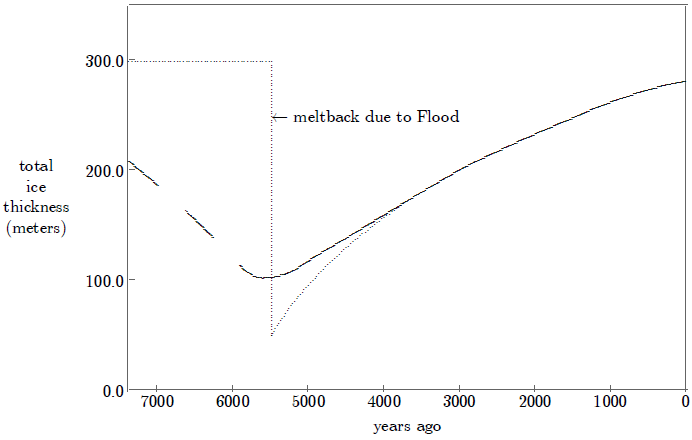 |
Going Further
These seven evidences doubtless do not exhaust the possibilities, but it is a little difficult to imagine what further evidence one might need. The data from Devon Island paint a picture of an ice cap frozen to its bed, suddenly melted back from the top to a mere 20% its former thickness about 5,500 years ago, thereafter resuming growth toward a new steady state balance. While this picture is most unexpected and surprising within the presently established secular view of earth history, it is predicted by the pelagic Flood model.
But let me take the argument one step further.
The Flood at Camp Century, Greenland
Across Baffin Bay from Devon Island (Figure 2, above) is Greenland, with its enormous ice sheet, large enough to stretch from southern Texas to the Canadian border, and wide enough to cover the five states in between. On the northwestern side of Greenland the first bore hole to ever penetrate that ice sheet was drilled at a site known as Camp Century. Less than 400 miles separate Camp Century and Devon Island. If the pelagic Flood caused such a dramatic effect at Devon Island, it surely must also have been felt at Camp Century.
The Greenland ice sheet, like the Devon Island ice cap, is frozen to its bed at present; the temperature of the ice at the base of the Camp Century bore hole is -13°C.[39] We have already seen that it is not possible to predict whether the Greenland ice sheet would have broken from its bed or not due to the buoyant force of the Flood waters. But we can confidently state that either it remained frozen to its bed with a resulting meltback similar to that at Devon Island, or it broke loose, in which case it would necessarily experience severe melting of its underside.
The Camp Century core does not show evidence of severe meltback from the top. For example, in contrast to Devon Island, the measured oxygen isotope ratios at Camp Century do not show any trend indicative of increasing altitude of snow deposition. We may, on this basis, confidently assert that the Greenland ice sheet did break loose from its bed and float on the waters of the Flood. That being the case, we may predict that the bottom ice at Camp Century will show signs of having once been melted.
The evidence of bottom melting at Camp Century is about as clear as the evidence of top melting at Devon Island. Herron and Langway summarize what has been found at the base of the Camp Century ice core as follows:[40]
The Camp Century, Greenland, ice core was recovered from a bore hole which extended 1375 m from the surface of the Greenland ice sheet to the ice/sub-ice interface. The bottom 15.7 m of the core contain over 300 alternating bands of clear and debris-laden ice.
and
The basal zone of this ice core contains numerous silt bands and small pebbles underlain by several meters of a till-like sub-ice material.
Contrast this with the basal ice at Devon Island:[41]
The ice-bedrock contact is sharp…
Detailed study of the Camp Century core revealed that only melting of the bottom ice and refreezing appeared able to explain the bottom 15.7 meters of the core:[42]
Both the low gas concentration in the debris-laden zone and the argon enrichment may be explained by the downward diffusion of gases from bubbly glacier ice into an originally bubble-free zone of refrozen debris-laden ice.
The evidence for melting and refreezing of the bottom ice at Camp Century is clear.
Unfortunately, there is no immediately obvious way to physically date when this melting and refreezing took place. But it is enough, for the time being at least, to simply note that the prediction of the pelagic Flood model that the bottom ice at Camp Century in Greenland would show signs of having once been melted also succeeds.
Conclusion
What is the likelihood of the pelagic Flood model successfully predicting such dramatic effects on these Arctic ice sheets if this model is not correct? If the bottom ice at Camp Century was not melted by the pelagic Flood, then what did melt it? If the Devon Island ice cap was not melted back from the top by the Flood, then what did cause the 80% meltback of this ice cap? Why should the top of the Devon Island ice cap be melted, while it was the bottom of the Greenland ice sheet which was melted? Why should the date of the meltback at Devon Island be synchronous with the date of the 500 times oversized annual layer at Elk Lake, and the dates of both of these events be indistinguishable from the date of Noah's Flood which Biblical chronology specifies? There is only one such oversized annual layer in ten thousand annual layers at Elk Lake; what is the probability it should have occurred at just the right date for the Flood? There is evidence of only one meltback in at least ten thousand years of ice at Devon Island; what are the chances it would date to just the time of the Flood?
The pelagic Flood model is clearly confirmed by the Devon Island and Greenland ice sheet data. In consequence the 3520±21 B.C. date for Noah's Flood calculated by the new Biblical chronology is also confirmed. This is the principal result.
A second, rather remarkable result follows immediately on the heels of this first one, however. We can now say that we know when Noah's Flood happened in history, and we can now point to several dramatic archaeological and geological effects of Noah's Flood in the real world. This is just another way of saying that Noah's Flood has been found.
The fact that Noah's Flood has been found falsifies the reigning theory within secular academia that Noah's Flood is but a myth. Please note that myths do not terminate whole, real-life civilizations, they do not leave sedimentary deposits 500 times thicker than normal at the bottom of real lakes, they do not melt very real ice sheets of enormous extent in polar regions of the real world, and they most especially don't do such things all at the same, specified time. Noah's Flood is clearly not a myth—it is sober history.
The fact that Noah's Flood has been found to have been geologically active in northern Canada and Greenland as well as having had a pronounced archaeological effect in the Middle East shows clearly that the Flood was not a mere local phenomenon.
And the facts that the Arctic ice sheets predate Noah's Flood and that they were merely melted back from above or below rather than entirely demolished by the Flood falsify the cataclysmic Flood model.
Noah's Flood has been found, and it has been found to be neither local nor cataclysmic.
When I say that Noah's Flood has been found I do not mean to imply that research on Noah's Flood is now complete. In many ways it is just beginning. As mentioned last issue,[43] our understanding of the physical behavior of Noah's Flood is still incomplete. Specifically, how the water of the Flood was caused to rise several miles above the level of the present-day oceans and remain there for a significant fraction of a year is still unknown. Additionally, the interrelated question of where all the water for the Flood came from and where it all went has not yet been resolved within the pelagic Flood model. So there is still much work to do and much to be learned. But the fact that the Flood has been found in earth history can no longer be reasonably disputed; and the date of the Flood—a date of great importance to the process of correctly harmonizing the Bible and secular studies—is, at long last, settled. ◇
Biblical Chronology 101
Is the Flood Missing at Oyster Pond?
David Neev of the Geological Society of Israel and K. O. Emery of the Woods Hole Oceanographic Institution in Massachusetts recently coauthored a book purporting to give the geological, climatological, and archaeological background to the Biblical accounts of the destructions at Sodom and Gomorrah and at Jericho.[44] My assessment is that they have failed rather badly in their purpose—an inevitable outcome of having given absolute chronology almost no attention—but that is another matter entirely. What I wish to discuss here, for its pedagogical value, is a claim found within their book. The claim is the following (square brackets indicate amplification by me):[45]
Confirmation of the absence of a world-encircling flood [i.e., Noah's Flood] during Late Holocene [i.e., anywhere near the time it is usually expected] is provided by studies of sediments in other lakes of the earth—for example, a coastal lake of Late Pleistocene glacial origin in Massachusetts in the United States, where flora, fauna [i.e., plant and animal life], and δ13C and δ18O [i.e., carbon and oxygen isotope ratios] show no changes that could have been expected from intrusion of seawater at the biblical date of Noah's Flood (Emery, 1969).
This claim is somewhat interesting in that it is quite unusual anymore to find a scientific work even pretending that Noah's Flood should be taken seriously enough to deserve evaluation relative to real-life data—so badly lost is modern science with respect to Noah's Flood. But what really captured my attention was that this is a claim that lake sediments from around the world prove a global Flood to be false. My recent investigation of Elk Lake, Minnesota, revealed exactly the opposite.[46] There the evidence in support of a global Flood was found to be really quite impressive. What gives?
The "(Emery, 1969)" reference is to a book entitled A Coastal Pond: Studied by Oceanographic Methods.[47] It is a slender little book, packed with scientific data of all sorts regarding Oyster Pond in Massachusetts. It contains, for example, graphs and discussion on the rate of escape of methane bubbles from pond sediments. If you find abstract scientific measurements stimulating, then this is the book for you. But if you are enquiring seriously into the historicity of Noah's Flood, I recommend you look elsewhere—I quickly found that this little book contains nothing to allow an intelligent conclusion on that particular question. Worse yet, Oyster Pond hardly recommends itself even for investigation of the question.
Recall that the major thing which recommended Elk Lake was the fact that its bottom sediments showed clear annual layering. These layers showed that the sediments had not been mixed (by fish or clams or worms) and they permitted a detailed chronology of the sediments to be worked out. That is, we could be confident that whatever Noah's Flood had done to the sediments at Elk Lake had been preserved, rather than mixed together with the sediments from before or after the Flood. Furthermore, we could be reasonably confident we would be able to locate the portion of the sediment column which should correspond to the Flood because the sediments themselves provided a reasonable chronology.
This nearly essential property—annually layered sediments—does not exist at Oyster Pond.
I would not go so far as to say that Neev and Emery's claim for Oyster Pond is intrinsically impossible, but I do want to point out that the substantiation of their claim demands that somebody have invested a prodigious amount of time and money in the project—much more even than was expended by the many researchers who labored over the Elk Lake sediments. Obviously, the most basic requirement, if one wishes to show that Noah's Flood is not represented at Oyster Pond, is an adequate chronology of the pond sediments, so one might tell in which portion of the thirteen meters of sediment at the bottom of the pond one should expect to find evidence of the Flood. In the absence of annual layering, establishing such a chronology is a major undertaking. (I would wish any scientist about to embark on such a project: abundant funding, good luck, and long life—they will likely need all three.) Unfortunately, there is no indication Neev or Emery or anyone else has done anything approaching the necessary work to meet even this most basic requirement.
What, quantitatively, would Noah's Flood have done to the "flora, fauna, and δ13C and δ18O" records at Oyster Pond? Neev and Emery provide no answer. But if Neev and Emery have made no quantitative estimate of the probable effects of Noah's Flood on these parameters at Oyster Pond, how can they conclude those effects are absent there? And where might we look to find their measurements of flora or fauna or δ13C or δ18O versus time at Oyster Pond? There is a low resolution pollen count versus depth of sediment graph, with two uncalibrated radiocarbon dates providing the only chronological indicators in a span of more than ten thousand years in "(Emery, 1969)"[48], but this is woefully inadequate to the present purpose. Beyond this I have been unable to find anything even remotely to the point in "(Emery, 1969)".
I conclude that Neev and Emery's claim that the Flood is absent at Oyster Pond is, at the very least, premature—they have written a conclusion to an experiment which they have not yet performed. I am prepared to accept that Oyster Pond may have the potential of making some contribution to our understanding of Noah's Flood, but there seems to me no way of avoiding the fact that a whole lot of measurements must be made before it can make that contribution.
Prejudice is rampant in academic circles at present wherever Biblical historicity is concerned. Many otherwise capable researchers and scholars are committing serious blunders because of it. Do not give any credence to their claims—demand to see the evidence. ◇
Readers Write
2 Chronicles 15:3–6
I have been asked on several occasions why the Bible is so completely silent about the millennium which has been lost from 1 Kings 6:1.[49] Why does the Bible provide no history to fill up this chronological gap?
There are a number of components to the answer to this question, but perhaps the most important is that the Bible isn't completely silent about this period. It is true that there is no deliberate historical narrative covering the 800 year interval between Samson and Samuel—just as there is none, for example, for roughly 400 years of the Israelites' stay in Egypt, and none for the centuries which separate the Old Testament from the New—but a number of allusions to this period do seem to appear within the Old Testament. I have previously mentioned Judges 18:30,[50] Deuteronomy 28:15–68 and 31:14–32:47,[51] and Psalm 78:56–64 in this regard.[52]
In the following letter Karl Wiensz points out that 2 Chronicles 15:3–6 seems also to refer to this 800 year period.
Dear Dr. Aardsma,
In my daily Bible reading this morning I came across a passage that caught my attention. I made a special trip to my pastor's house where all the issues of The Biblical Chronologist are kept. I quickly thumbed through all of the issues to see if you had made comment on it. You had not.
The passage is 2 Chronicles 15:1–7. The Holy Spirit came on the man Azariah to prophesy to King Asa. Verses 3 through 6 say [NIV]:
For a long time Israel was without the true God, without a priest to teach and without the law. But in their distress they turned to the LORD, the God of Israel, and sought him, and he was found by them. In those days it was not safe to travel about, for all the inhabitants of the lands were in great turmoil. One nation was being crushed by another and one city by another, because God was troubling them with every kind of distress."
I hope the relevancy of this passage to your premise is obvious. Azariah appears to be making reference not to the recent revolt against Rehoboam, but to an ancient revolt against God. Notice the length and intensity of Israel's condition. It does seem more severe than what is recorded in the Judges.
This passage reminded me of your citation of Psalm 78…
Karl Wiensz
Rickreall, OR
Dear Karl,
Your observation seems to me to be a good one, and very probably correct. Verses 5 and 6 resonate immediately with all we learn from archaeology of the Israelites' plight in the 800 years between Samson and Samuel. I hadn't thought of this passage in this regard, and nobody has previously pointed it out to me. Thank you so much for having done so.
Gerald E. Aardsma, Ph.D.
Loda, IL
The Biblical Chronologist is a bimonthly subscription newsletter about Biblical chronology. It is written and edited by Gerald E. Aardsma, a Ph.D. scientist (nuclear physics) with special background in radioisotopic dating methods such as radiocarbon. The Biblical Chronologist has a threefold purpose: to encourage, enrich, and strengthen the faith of conservative Christians through instruction in Biblical chronology, to foster informed, up-to-date, scholarly research in this vital field within the conservative Christian community, and to communicate current developments and discoveries in Biblical chronology in an easily understood manner.
An introductory packet containing three sample issues and a subscription order form is available for $9.95 US regardless of destination address. Send check or money order in US funds and request the "Intro Pack."
The Biblical Chronologist (ISSN 1081-762X) is published six times a year by Aardsma Research & Publishing, 412 N Mulberry, Loda, IL 60948-9651. Copyright © 1997 by Aardsma Research & Publishing. Photocopying or reproduction strictly prohibited without written permission from the publisher. |
Footnotes
^ Gerald E. Aardsma, "Noah's Flood at Elk Lake," The Biblical Chronologist 2.6 (November/December 1996): 8,10.
^ Gerald E. Aardsma, "Chronology of the Bible: 5000–3000 B.C.," The Biblical Chronologist 2.4 (July/August 1996): 2–3.
^ Gerald E. Aardsma, "The Depth of Noah's Flood," The Biblical Chronologist 3.3 (May/June 1997): 8.
^ Gerald E. Aardsma, "The Depth of Noah's Flood," The Biblical Chronologist 3.3 (May/June 1997): 1–10.
^ Hershel Shanks, "Is This Man a Biblical Archaeologist?" Biblical Archaeology Review 22.4 (July/August 1996): 62.
^ John C. Whitcomb, Jr. and Henry M. Morris, The Genesis Flood (Philadelphia: The Presbyterian and Reformed Publishing Company, 1961), 265.
^ Sir Leonard Woolley, Spadework in Archaeology (New York: Philosophical Library, 1953), 105-106. Arthur C. Custance, The Flood: Local or Global? (Grand Rapids: Zondervan, 1979).
^ Gerald E. Aardsma, "Research in Progress," The Biblical Chronologist 1.1 (January/February 1995): 6–7. Gerald E. Aardsma, "Research in Progress," The Biblical Chronologist 1.2 (March/April 1995): 6–8. Gerald E. Aardsma, "Research in Progress," The Biblical Chronologist 1.4 (July/August 1995): 6–10.
^ Gerald E. Aardsma, "Research in Progress," The Biblical Chronologist 2.4 (July/August 1996): 9–14.
^ Gerald E. Aardsma, "Noah's Flood at Elk Lake," The Biblical Chronologist 2.6 (November/December 1996): 1–13.
^ C. W. Ferguson, "Bristlecone Pine: Science and Esthetics," Science 159 (23 February 1968): 839–846.
^ C. W. Ferguson, Barbara Lawn, and H. N. Michael, "Prospects for the Extension of the Bristlecone Pine Chronology: Radiocarbon Analysis of H-84-1," Meteoritics Vol. 20, No. 2, Part 2 (30 June 1985): 415–421.
^ C. W. Ferguson, "Bristlecone Pine: Science and Esthetics," Science 159 (23 February 1968): 839.
^ Gerald E. Aardsma, "The Depth of Noah's Flood," The Biblical Chronologist 3.3 (May/June 1997): 10 (Figure 2).
^ Harold C. Fritts, "Bristlecone Pine in the White Mountains of California: Growth and Ring-Width Characteristics," Papers of the Laboratory of Tree-ring Research, Number 4 (Tucson: The University of Arizona Press, 1969), 18.
^ C. W. Ferguson, "Bristlecone Pine: Science and Esthetics," Science 159 (23 February 1968): 841.
^ The idea of a pre-Flood vapor canopy and consequent world-wide warm pre-Flood climate attaches to the cataclysmic Flood model only. (See: John C. Whitcomb, Jr. and Henry M. Morris, The Genesis Flood (Philadelphia: The Presbyterian and Reformed Publishing Company, 1961), 243–258.) Simple chronological considerations forbid such a scenario within the pelagic Flood model.
^ CRC Handbook of Chemistry and Physics 77th edition, section 6, page 15.
^ George L. Pickard and William J. Emery, Descriptive Physical Oceanography: an Introduction, 4th (SI) enlarged edition (New York: Pergamon Press, 1982), 34–43.
^ W. F. Weeks, "Tensile Strength of NaCl Ice," Journal of Glaciology 4.31 (1962): 46.
^ W. F. Weeks, "Tensile Strength of NaCl Ice," Journal of Glaciology 4.31 (1962): 34 (Table I).
^ M. P. Langleben and E. R. Pounder, "Arctic Sea Ice of Various Ages: I. Ultimate Strength," Journal of Glaciology 5 (1964): 95 (Table I).
^ George L. Pickard and William J. Emery, Descriptive Physical Oceanography: an Introduction, 4th (SI) enlarged edition (New York: Pergamon Press, 1982), 17–21.
^ George L. Pickard and William J. Emery, Descriptive Physical Oceanography: an Introduction, 4th (SI) enlarged edition (New York: Pergamon Press, 1982), 184.
^ H. Shoji and C. C. Langway, Jr., "Physical Property Reference Horizons," The Environmental Record in Glaciers and Ice Sheets, ed. H. Oeschger and C. C. Langway, Jr. (New York: John Wiley & Sons, 1989), 161–162.
^ W. S. B. Paterson, "Vertical Strain-rate Measurements in an Arctic Ice Cap and Deductions from Them," Journal of Glaciology 17.75 (1976): 4.
^ W. S. B. Paterson, "Vertical Strain-rate Measurements in an Arctic Ice Cap and Deductions from Them," Journal of Glaciology 17.75 (1976): 4.
^ Gerald E. Aardsma, "The Depth of Noah's Flood," The Biblical Chronologist 3.3 (May/June 1997): 10 (Figure 2).
^ R. M. Koerner and D. A. Fisher, "Discontinuous Flow, Ice Texture, and Dirt Content in the Basal Layers of the Devon Island Ice Cap," Journal of Glaciology 23.89 (1979): 218.
^ W. S. B. Paterson, R. M. Koerner, D. Fisher, S. J. Johnsen, H. B. Clausen, W. Dansgaard, P. Bucher, and H. Oeschger, "An Oxygen-isotope Climatic Record from the Devon Island Ice Cap, Arctic Canada," Nature 266 (7 April 1977): 509.
^ N. Reeh and W. S. B. Paterson, "Application of a Flow Model to the Ice-divide Region of Devon Island Ice Cap, Canada," Journal of Glaciology 34.116 (1988): 62, Table I.
^ N. Reeh and W. S. B. Paterson, "Application of a Flow Model to the Ice-divide Region of Devon Island Ice Cap, Canada," Journal of Glaciology 34.116 (1988): 56.
^ W. S. B. Paterson and E. D. Waddington, "Past Precipitation Rates Derived from Ice Core Measurements: Methods and Data Analysis," Reviews of Geophysics and Space Physics 22.2 (May 1984): 126.
^ The data for this figure are from W. S. B. Paterson, R. M. Koerner, D. Fisher, S. J. Johnsen, H. B. Clausen, W. Dansgaard, P. Bucher, and H. Oeschger, "An Oxygen-isotope Climatic Record from the Devon Island Ice Cap, Arctic Canada," Nature 266 (7 April 1977): 510.
^ W. S. B. Paterson, R. M. Koerner, D. Fisher, S. J. Johnsen, H. B. Clausen, W. Dansgaard, P. Bucher, and H. Oeschger, "An Oxygen-isotope Climatic Record from the Devon Island Ice Cap, Arctic Canada," Nature 266 (7 April 1977): 510.
^ W. S. B. Paterson and E. D. Waddington, "Past Precipitation Rates Derived from Ice Core Measurements: Methods and Data Analysis," Reviews of Geophysics and Space Physics 22.2 (May 1984): 126.
^ N. Reeh and W. S. B. Paterson, "Application of a Flow Model to the Ice-divide Region of Devon Island Ice Cap, Canada," Journal of Glaciology 34.116 (1988): 62.
^ N. Reeh, "Dating by Ice Flow Modeling: A Useful Tool or an Exercise in Applied Mathematics?" The Environmental Record in Glaciers and Ice Sheets, ed. H. Oeschger and C. C. Langway, Jr. (New York: John Wiley & Sons, 1989), 156.
^ Susan Herron and Chester C. Langway, Jr., "The Debris-laden Ice at the Bottom of the Greenland Ice Sheet," Journal of Glaciology 23.89 (1979): 194.
^ Susan Herron and Chester C. Langway, Jr., "The Debris-laden Ice at the Bottom of the Greenland Ice Sheet," Journal of Glaciology 23.89 (1979): 193.
^ R. M. Koerner and D. A. Fisher, "Discontinuous Flow, Ice Texture, and Dirt Content in the Basal Layers of the Devon Island Ice Cap," Journal of Glaciology 23.89 (1979): 211.
^ Susan Herron and Chester C. Langway, Jr., "The Debris-laden Ice at the Bottom of the Greenland Ice Sheet," Journal of Glaciology 23.89 (1979): 185.
^ Gerald E. Aardsma, "The Depth of Noah's Flood," The Biblical Chronologist 3.3 (May/June 1997): 9.
^ David Neev and K. O. Emery, The Destruction of Sodom, Gomorrah, and Jericho, (New York: Oxford University Press, 1995).
^ David Neev and K. O. Emery, The Destruction of Sodom, Gomorrah, and Jericho, (New York: Oxford University Press, 1995), 120.
^ Gerald E. Aardsma, "Noah's Flood at Elk Lake," The Biblical Chronologist 2.6 (November/December 1996): 1–13.
^ K. O. Emery, A Coastal Pond: Studied by Oceanographic Methods, (New York: Elsevier, 1969).
^ K. O. Emery, A Coastal Pond: Studied by Oceanographic Methods, (New York: Elsevier, 1969), 25 (Figure 15).
^ Gerald E. Aardsma, A New Approach to the Chronology of Biblical History from Abraham to Samuel, 2nd ed. (Loda IL: Aardsma Research and Publishing, 1993).
^ Gerald E. Aardsma, A New Approach to the Chronology of Biblical History from Abraham to Samuel, 2nd ed. (Loda IL: Aardsma Research and Publishing, 1993) 99.
^ Gerald E. Aardsma, "The Chronology of Egypt in Relation to the Bible: 3000–1000 B.C.," The Biblical Chronologist 2.2 (March/April 1996): 8.
^ Gerald E. Aardsma, "The Chronology of Egypt in Relation to the Bible: 3000–1000 B.C.," The Biblical Chronologist 2.2 (March/April 1996): 9.




